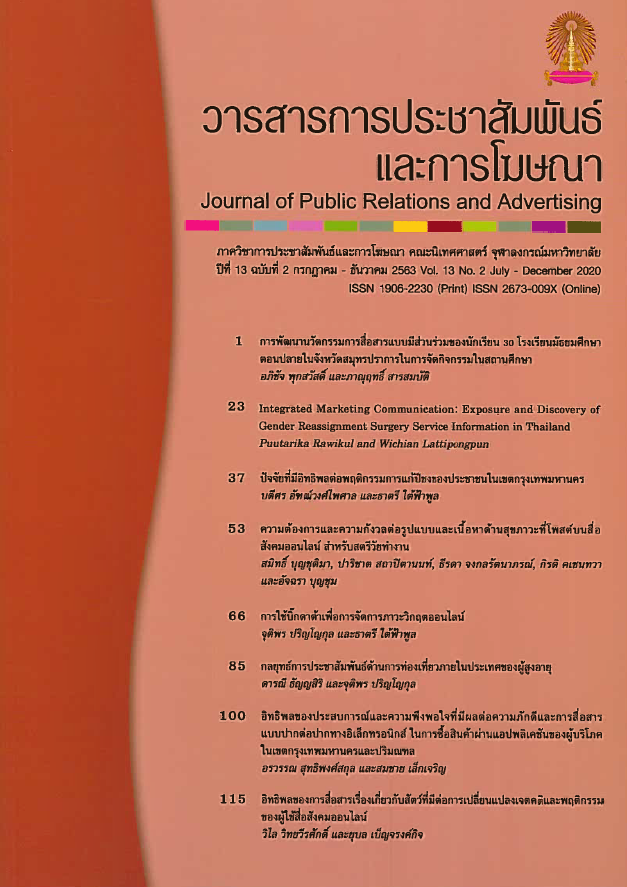การพัฒนานวัตกรรมการสื่อสารแบบมีส่วนร่วมของนักเรียน 30 โรงเรียนมัธยมศึกษาตอนปลายในจังหวัดสมุทรปราการในการจัดกิจกรรมในสถานศึกษา
Main Article Content
บทคัดย่อ
การวิจัยครั้งนี้มีวัตถุประสงค์เพื่อสำรวจสถานภาพการจัดกิจกรรมนักเรียนของ 30 โรงเรียนมัธยมศึกษาตอนปลายในจังหวัดสมุทรปราการ เพื่อศึกษาสถานภาพการสื่อสารแบบมีส่วนร่วมของนักเรียน 30 โรงเรียนมัธยมศึกษาตอนปลายในจังหวัดสมุทรปราการในการจัดกิจกรรมในสถานศึกษา รวมทั้งเพื่อสร้างรูปแบบนวัตกรรมการสื่อสารแบบมีส่วนร่วมของนักเรียน 30 โรงเรียนมัธยมศึกษาตอนปลายในจังหวัดสมุทรปราการในการจัดกิจกรรมในสถานศึกษา ตลอดจนเพื่อสร้างการยอมรับรูปแบบนวัตกรรมการสื่อสารแบบมีส่วนร่วมของนักเรียน 30 โรงเรียนมัธยมศึกษาตอนปลายในจังหวัดสมุทรปราการในการจัดกิจกรรมในสถานศึกษาจากอาจารย์ที่ปรึกษากิจกรรมงานวิจัยครั้งนี้เป็นการวิจัยแบบผสมผสาน (Mixed Method) แบ่งเป็น 4 ระยะ คือ 1) การวิจัยคุณภาพ เลือกกลุ่มตัวอย่างแบบเฉพาะเจาะจงและใช้การสนทนากลุ่มย่อยกับอาจารย์ที่ปรึกษากิจกรรมและนักเรียนมัธยมศึกษาตอนปลายจำนวน 10 คน 2) การวิจัยเชิงปริมาณ เลือกกลุ่มตัวอย่างตามสัดส่วนของ Taro Yamane ใช้แบบสอบถามเก็บข้อมูลกับนักเรียนมัธยมศึกษาตอนปลายจำนวน 400 คน 3) การวิจัยเชิงคุณภาพ เลือกกลุ่มตัวอย่างแบบเฉพาะเจาะจงและใช้การวิจัยเชิงปฏิบัติการแบบมีส่วนร่วมกับนักเรียนมัธยมศึกษาตอนปลายจำนวน 30 คน และ 4) การวิจัยเชิงคุณภาพ เลือกกลุ่มตัวอย่างแบบเฉพาะเจาะจงและใช้การสนทนากลุ่มย่อยกับอาจารย์ที่ปรึกษาจำนวน 10 คน ผลการวิจัยพบว่า การจัดกิจกรรมในสถานศึกษาประกอบด้วย 1) รูปแบบและลักษณะของกิจกรรมแบ่งเป็น 2 ประเภท คือ (1.1) กิจกรรมของภาคส่วนต่างๆ ของโรงเรียนและ (1.2) กิจกรรมที่ดำเนินงานโดยสภานักเรียน 2) รูปแบบและการสื่อสารเพื่อการประชาสัมพันธ์กิจกรรม ประกอบด้วย (2.1)กระบวนการการวางแผนการสื่อสาร และ (2.2) การออกแบบเนื้อหาเพื่อการประชาสัมพันธ์ 3) กระบวนการวางแผนกิจกรรรมประกอบด้วย (3.1) การวางแผนและออกแบบกิจกรรม (3.2) การปฏิบัติการและการสื่อสาร (3.3) การประเมินผลกิจกรรม การมีส่วนร่วมในการจัดกิจกรรมในสถานศึกษา
กลุ่มตัวอย่างมีส่วนร่วมในขั้นตอนของการวางแผนกิจกรรมโรงเรียนในระดับ “ปานกลาง” มีส่วนร่วมในระดับปฏิบัติการในระดับ “ปานกลาง” การสื่อสารแบบมีส่วนร่วมในการจัดกิจกรรมในสถานศึกษา กลุ่มตัวอย่างมีส่วนร่วมในฐานะผู้รับสารในระดับ “มาก”
การวิจัยเชิงปฏิบัติการแบบมีส่วนร่วมมี 3 ขั้นตอน คือ 1) ขั้นเตรียมความคิด ประกอบด้วย (1.1) วิเคราะห์บริบทโรงเรียน (1.2) ประเมินความสามารถทางการสื่อสารเพื่อการประชาสัมพันธ์ กลุ่มตัวอย่างมีความสามารถทางการสื่อสารเพื่อการประชาสัมพันธ์ในระดับ “ปานกลาง” และ (1.3) ตั้งโจทย์การวิจัย กลุ่มตัวอย่างใช้การเล่าเรื่องอัตลักษณ์โรงเรียนโดยใช้การเล่าเรื่องผ่านสื่อประชาสัมพันธ์ของสถาบันการศึกษา 2) ขั้นปฏิบัติการ ประกอบด้วย (2.1) กลุ่มตัวอย่างมีส่วนร่วมในการวางแผนการปฏิบัติการภายใต้กรอบแนวคิด PDCA (Plan, Do, Check, Action) (2.2) การสื่อสารแบบมีส่วนร่วม กลุ่มตัวอย่างมีส่วนร่วมในฐานะผู้รับสาร/ผู้ใช้สาร/มีส่วนร่วมในฐานะผู้ส่งสาร/ผู้ผลิตสื่อ/มีส่วนร่วมในในฐานะผู้วางแผน 3) ขั้นถอดบทเรียน ประกอบด้วย (3.1) ประเมินความสามารถทางการสื่อสารเพื่อการประชาสัมพันธ์ กลุ่มตัวอย่างมีความสามารถทางการสื่อสารเพื่อการประชาสัมพันธ์ในระดับ “มาก” (3.2) ประเมินผลที่เกิดขึ้นกับกลุ่มตัวอย่าง กลุ่มตัวอย่างมีความรับผิดชอบต่อหน้าที่กิจกรรมนักเรียน มีความรู้ ความสามารถในการจัดกิจกรรม ในระดับ “มาก” และมีคุณลักษณะส่วนบุคคล ในระดับ “มากที่สุด”
Article Details
เอกสารอ้างอิง
ภาษาไทย
กาญจนา แก้วเทพ. (2543). การสื่อสารกับชุมชน: แนวคิดหลักเพื่อการพัฒนา. วารสารนิเทศศาสตร์, 18(2) 61-77.
______________. (2548). ก้าวต่อไปของการสื่อสารเพื่อการพัฒนาชุมชน. กรุงเทพฯ: สำนักงานกองทุนสนับสนุนการวิจัย (สกว.).
สถาบันวิจัยสังคมและสถาบันวิจัยสภาวะแวดล้อม จุฬาลงกรณ์มหาวิทยาลัย. (2545). โครงการพัฒนาการดำเนินงานการมีส่วนร่วมของประชาชนในกระบวนการวิเคราะห์ผลกระทบสิ่งแวดล้อม. กรุงเทพฯ: โรงพิมพ์จุฬาลงกรณ์มหาวิทยาลัย.
ศศโสฬส จิตรวานิชกุล. (2559). การสื่อสารชุมชนกับการพัฒนาเด็กและเยาวชน ใน เอกสารการสอนชุดวิชาความรู้เบื้องต้นการสื่อสารชุมชน หน่วยที่ 6-10. นนทบุรี: สำนักพิมพ์มหาวิทยาลัยสุโขทัยธรรมาธิราช.
สมศักดิ์ คงเที่ยง. (2529). ED408 การบริหารกิจการนักเรียน (Student Personnel Administration). วันที่เข้าถึงข้อมูล 2 กุมภาพันธ์ 2561, แหล่งที่มา http://e-book.ram.edu/e-book/inside/html/dlbook.asp?code=ED408
สำนักงานปลัดกระทรวงศึกษา กระทรวงศึกษาธิการ. (2560). แผนพัฒนาการศึกษาของกระทรวงศึกษาธิการ ฉบับที่ 12 (2560-2564). กรุงเทพฯ: กระทรวงศึกษาธิการ.
สำนักงานคณะกรรมการพัฒนาการเศรษฐกิจและสังคมแห่งชาติ สำนักนายกรัฐมนตรี (2560). แผนพัฒนาเศรษฐกิจและสังคมแห่งชาติฉบับที่ 12 (พ.ศ.2560-2564). กรุงเทพฯ: สำนักนายกรัฐมนตรี.
ภาษาอังกฤษ
Berlo, D.K. (1960). Process of Communication: An Introduction to Theory and Practice. NY: Holt, Rinehart and Winston.
Dargon, A.G. (2001). Introductuion. In Dargon, A.G., Ed. Making Waves: Stories of Participation Communication for Social Change. New York: Rockefeller Foundation.
Mercado, Cesar M. (1999). Development Communication Management. The Journal of Development Communication, 12(2), 13-25.
Mody, B. (2000). The Context of Power and the Power of Media. In Wilkins, K.G. Ed., Redeveloping Communication for Social Change:Theory, Practice, and Power. Lanham, ML: Rowman & Littlefield.
Rogers, E. (2003). Diffusion of Innovation. New York: Free Press.
Servaes, J; Jacobson. T.L; White, S.A. Eds. (1996). Participation Communication for Social Change. New Delhi: Sage.
United Nations. (1983). Popular Participation as a Strategy for Promoting Community Level Action and Nation. New York: United Nations.
White, S.A. (2003). In Involving People in a Participatory Process. In White, S.A. Eds. Participatory Video Images that Transform and Empower. New Delhi: Sage.
Wilkins, K.G. (2000). Redeveloping Communication for Social Change: Theory, Practice, and Power. Lanham, ML: Rowman & Littlefield.


